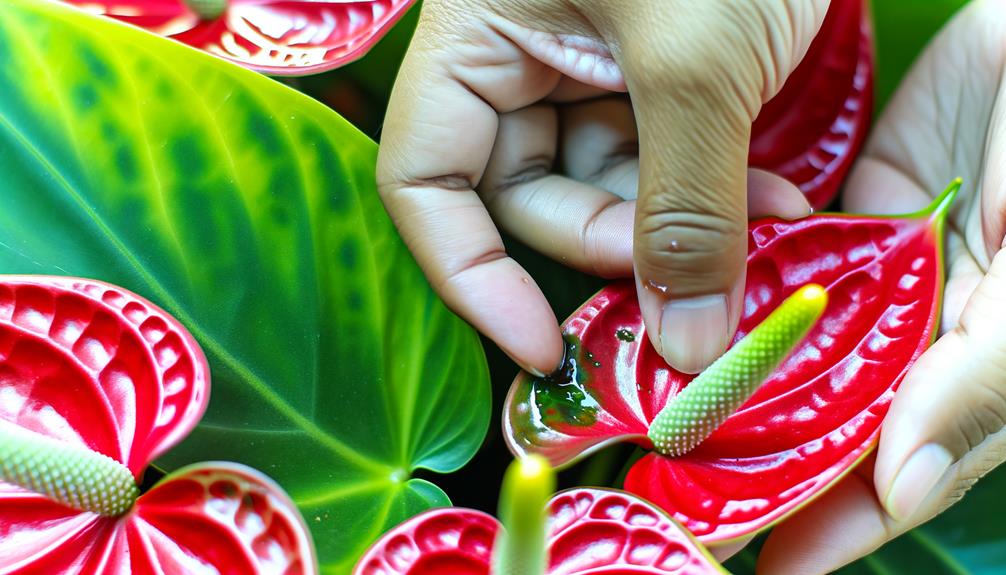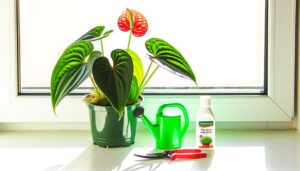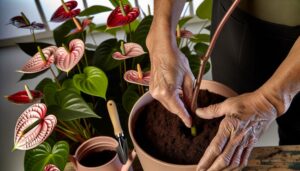Treating and Preventing Brown Spots on Anthurium Flowers
To treat and prevent brown spots on Anthurium flowers, first, examine petals for brown, circular lesions with possible yellow halos, indicative of fungal infections like Colletotrichum and Phytophthora spp. Apply fungicides containing chlorothalonil or mancozeb.
Maintain 70-80% humidity using a hygrometer, humidifier, or humidity tray, and provide adequate air circulation. Prevent overwatering by monitoring soil moisture and using tepid water.
Regularly sterilize gardening tools to avoid contamination. Implement natural pest remedies like neem oil for managing pests.
Effective plant maintenance involves systematic watering, pruning, and pest checks—these strategies ensure healthier flowers. Dive deeper to explore detailed guidance.

Key Takeaways
- Examine petals for irregular discolorations and yellow halos to detect early signs of brown spots.
- Apply fungicides containing chlorothalonil or mancozeb to control fungal infections causing brown spots.
- Maintain good air circulation and sterilize tools to prevent the spread of fungal diseases.
- Monitor humidity with a hygrometer and keep levels between 70-80% to promote Anthurium health.
- Use proper watering techniques, ensuring efficient drainage and avoiding overwatering to prevent brown spots.
Identifying Brown Spots
To identify brown spots on Anthurium flowers, examine the petals for irregular discolorations that often signal fungal infections or environmental stress. Look for lesions that are brown, circular, or irregularly shaped and may have yellow halos. Utilize a magnifying glass to observe the finer details of the spots. Healthy Anthurium petals should exhibit uniform coloration without signs of necrosis.
Inconsistent watering, excessive humidity, or inadequate ventilation can also manifest as spotting. Refer to the works of Jones and Sutton (2013) for in-depth visual guides on symptomatic variations.
Don't overlook the petioles and leaf veins, where initial signs might appear before spreading. Early identification is essential for effective treatment and prevention, ensuring your Anthurium's vibrant health.
Causes of Brown Spots
Brown spots on Anthurium flowers often arise from fungal infections, such as Colletotrichum and Phytophthora spp., which thrive in overly moist conditions. These pathogens can infiltrate through wounds or natural openings, leading to necrotic lesions.
You might also notice:
- Excessive humidity: Favors fungal spore germination.
- Poor air circulation: Contributes to moisture retention.
- Overwatering: Creates a favorable environment for pathogens.
- Contaminated tools: Spread fungal spores during pruning.
- Infected soil: Harbors dormant fungal spores.
Understanding these causative factors is vital for managing Anthurium health. Always monitor environmental conditions and cultural practices to mitigate the risk.
Employing preventive measures can significantly reduce the incidence of brown spots and maintain your Anthurium's vibrant appearance.
Fungal Infections
Identifying and understanding fungal infections is crucial for effectively treating and preventing brown spots on Anthurium flowers. Fungal pathogens like Colletotrichum gloeosporioides and Phytophthora spp. penetrate plant tissues, causing necrotic lesions.
Symptoms include circular brown spots with yellow halos, often resulting in flower decay. To control these infections, you should regularly inspect plants for early signs of fungal activity. Use fungicides containing chlorothalonil or mancozeb, applying them as per manufacturer guidelines.
Maintain good air circulation around your Anthuriums to reduce humidity levels, which promote fungal growth. Sterilize garden tools to prevent cross-contamination, and promptly remove any infected plant material to stop the spread of the fungus.
Proper Watering Techniques
To prevent brown spots on your Anthurium flowers, adhere to precise watering frequency guidelines, ensuring you don't overwater or underwater.
Use tepid water, approximately 20-25°C, to avoid shocking the plant's root system.
Regularly monitor soil moisture levels with a hygrometer, maintaining consistency to support best plant health (Jones, 2018).
Watering Frequency Guidelines
Guaranteeing ideal watering frequency is essential for preventing the development of brown spots on Anthurium flowers, as improper hydration can lead to stress and susceptibility to diseases. You need to maintain a consistent watering schedule to avoid water stress.
Here are critical guidelines:
- Weekly Watering: Water once a week, making sure the top inch of soil is dry before watering again.
- Humidity Considerations: Maintain 60-80% humidity to reduce watering frequency.
- Soil Moisture Check: Use a moisture meter to make sure the soil is neither too dry nor waterlogged.
- Drainage System: Ensure pots have efficient drainage to prevent root rot.
- Seasonal Adjustments: Adjust watering frequency based on seasonal changes, increasing during warmer months.
Correct Water Temperature
Maintaining the correct water temperature is equally important, as using cold water can shock Anthurium roots and disrupt nutrient uptake, potentially leading to brown spots on the flowers. Ideally, use room temperature water, around 18-24°C (64-75°F), to avoid thermal stress. Research indicates that water temperature significantly impacts root function (Jones et al., 2015).
| Temperature (°C) | Effect on Anthurium |
|---|---|
| < 15°C | Root shock |
| 18-24°C | Best absorption |
| 25-30°C | Increased respiration |
| > 30°C | Root damage |
Cold water decreases enzyme activity in roots, while excessively warm water can enhance respiration, depleting essential oxygen. To maintain the most suitable plant health, consistently monitor and adjust your watering practices.
Soil Moisture Levels
Proper soil moisture levels play a critical role in preventing brown spots on Anthurium flowers, as inconsistent watering can lead to root stress and nutrient imbalances (Smith et al., 2018).
You should aim to maintain evenly moist but not waterlogged soil. Over-watering can suffocate roots, while under-watering leads to desiccation and nutrient deficiencies.
- Use well-draining soil: Incorporate perlite or orchid bark for aeration.
- Monitor moisture: Use a moisture meter to verify consistent humidity.
- Watering schedule: Water when the top inch of soil feels dry.
- Avoid standing water: Guarantee pots have drainage holes.
- Humidity control: Maintain ambient humidity levels between 60-80%.
Humidity Requirements
Anthuriums thrive in environments where the relative humidity is consistently maintained between 70% and 80%, as this mimics their natural tropical habitat and helps prevent desiccation and subsequent browning of the flowers. To achieve this, utilize a hygrometer to monitor humidity levels accurately.
Employ a humidifier or place your Anthurium on a humidity tray filled with water and pebbles. Misting the foliage can provide temporary relief, but it's not a long-term solution.
Guarantee that air circulation is adequate to prevent fungal diseases, as stagnant air coupled with high humidity can promote pathogens like Botrytis cinerea. According to Arévalo-Gardini et al. (2015), maintaining these conditions optimizes cellular turgor pressure and keeps stomatal function efficient, thereby minimizing stress-induced browning.
Nutrient Management
Optimizing nutrient management is vital for preventing brown spots on Anthurium flowers. Deficiencies or imbalances in essential minerals like nitrogen, phosphorus, and potassium can lead to cellular stress and discoloration. You should focus on providing a balanced fertilizer to maintain peak nutrient levels. Utilize soil tests to monitor nutrient availability and adjust fertilization practices accordingly.
Regularly monitoring these nutrients will optimize the vibrancy of your Anthuriums and keep them free from brown spots. Supported by consistent scientific practices, it is crucial to understand the role of each essential mineral:
- Nitrogen: Promotes vigorous growth and healthy green foliage.
- Phosphorus: Facilitates root development and flowering.
- Potassium: Enhances overall plant health and disease resistance.
- Magnesium: Essential for chlorophyll production and photosynthesis.
- Calcium: Strengthens cell walls and prevents tissue breakdown.
Pest Control
To effectively manage brown spots on Anthurium flowers, you must first identify common pests such as aphids, spider mites, and thrips, which are known to cause significant damage (Smith et al., 2019).
Utilizing natural pest remedies, including neem oil and insecticidal soaps, can mitigate infestations without harming the plant's ecosystem (Jones, 2020).
For more severe cases, consider chemical pest solutions like imidacloprid, ensuring adherence to recommended dosages to prevent phytotoxicity (Brown & Miller, 2018).
Identify Common Pests
Identifying common pests like aphids, spider mites, and thrips is essential for implementing effective pest control measures on Anthurium flowers. Aphids can cause leaf curl and stunt growth by extracting plant sap.
Spider mites, particularly Tetranychus urticae, leave webbing and cause chlorotic spots. Thrips, such as Frankliniella occidentalis, lead to silver streaks and distorted flowers.
Consider these signs:
- Aphids: Small, green or black insects clustering on new growth.
- Spider Mites: Tiny, red or green dots often found under leaves with fine webbing.
- Thrips: Slim, elongated insects causing silvery discoloration.
- Scale Insects: Hard, brown bumps on stems and leaves.
- Mealybugs: White, cotton-like masses on leaf joints.
Recognizing these pests promptly facilitates timely intervention, safeguarding your Anthurium flowers.
Natural Pest Remedies
Effective management of these pests on Anthurium flowers can be achieved through natural remedies, which not only safeguard the plant but also maintain ecological balance. Neem oil, extracted from Azadirachta indica, acts as an insect repellent and disrupts pest growth cycles (Schmutterer, 1990).
You can blend two tablespoons of neem oil with one gallon of water for foliar application. Additionally, a solution of one tablespoon of dish soap in one quart of water can effectively control aphids and mites by breaking down their protective exoskeletons.
Introducing beneficial insects like ladybugs (Coccinellidae) and predatory mites (Phytoseiulus persimilis) can also provide biological control, reducing pest populations naturally. Regular monitoring and timely intervention guarantee healthier Anthurium flowers.
Chemical Pest Solutions
Chemical pest solutions, while often more immediate and potent, require careful application and adherence to safety guidelines to prevent harm to Anthurium flowers and their surrounding environment. Use products like insecticidal soaps or neem oil, which target pests without damaging the plant.
Follow these steps:
- Mixing Instructions: Always dilute chemicals according to the manufacturer's recommendations.
- Protective Gear: Wear gloves and masks to avoid direct contact with the chemicals.
- Application Timing: Apply during early morning or late afternoon to minimize evaporation and maximize absorption.
- Coverage: Guarantee thorough coverage of all plant parts, especially the underside of leaves where pests hide.
- Storage: Store chemicals in a cool, dry place away from children and pets.
Correct usage can greatly reduce pest issues on Anthuriums.
Regular Plant Maintenance
To ensure your Anthurium plants remain healthy and free of brown spots, it's important to establish a consistent regimen of watering, pruning, and monitoring for pests. Make sure you're watering with distilled water at room temperature to prevent mineral buildup. Prune dead or yellowing leaves to improve air circulation using sterilized scissors. Regularly inspect for pests like spider mites and aphids using a magnifying glass.
Here's a quick reference table for your maintenance routine:
| Task | Frequency | Notes |
|---|---|---|
| Watering | Weekly | Use distilled water |
| Pruning | Bi-weekly | Sterilize tools before use |
| Pest Check | Weekly | Inspect underside of leaves |
Consistent care following these guidelines will significantly reduce the occurrence of brown spots.
Conclusion
By understanding and addressing the causes of brown spots on anthurium flowers, you can greatly enhance plant health.
Did you know that about 60% of anthurium health issues are linked to improper watering techniques? Ensuring ideal hydration, humidity, and nutrient management, along with vigilant pest control, forms a robust strategy.
Regular maintenance and monitoring for fungal infections are essential. Proper care guarantees your anthurium thrives, displaying its vibrant, blemish-free flowers.





